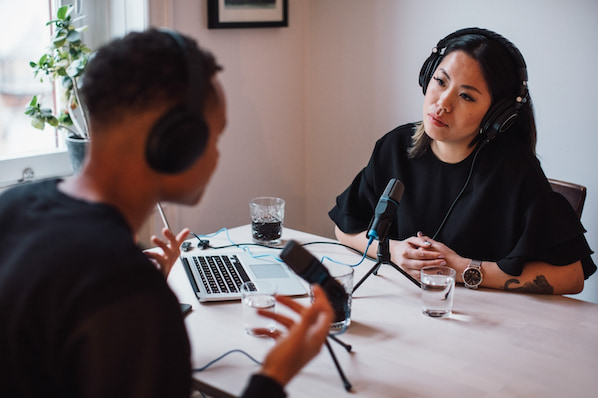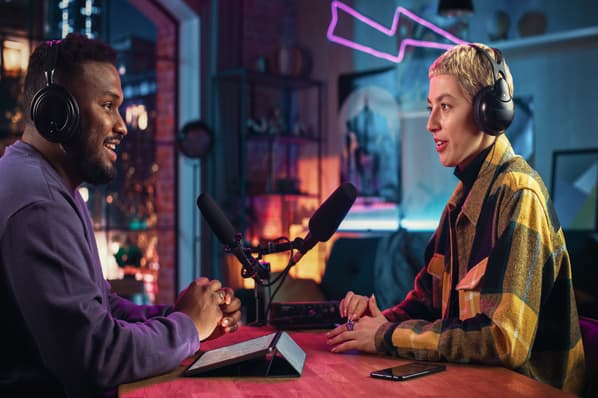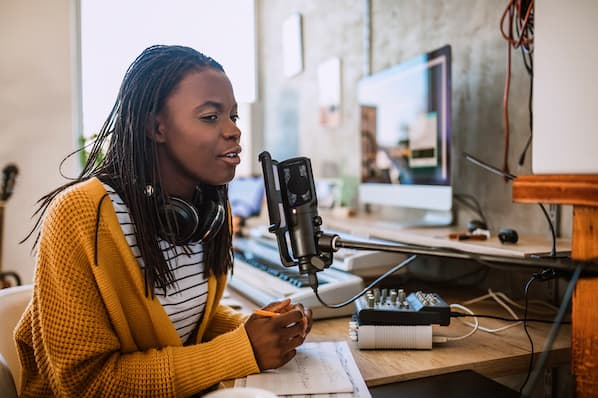Want to launch your own podcast (or a podcast for your company) but don’t know where to start? I’ve put together a podcast launch checklist you can use to get your project up and running, along with tips gathered from my personal experience and insights from members of the HubSpot Podcast Network.

Let’s rewind before 2018, when I started my own show, Balanced Black Girl. I was one of the estimated 120 million people listening to podcasts monthly. Eventually, I had an idea of my own and was able to launch with no prior audio experience — and if I can do it, you can, too.
In fact, starting a podcast is easier than ever as the medium has increased in popularity and profitability. Here’s the ultimate checklist to help you start a successful podcast.
Table of Contents
- Starting a Podcast Checklist
- Things To Know Before Starting a Podcast
- Everything You Need to Start Your Podcast Today
Starting a Podcast Checklist
- Determine your niche.
- Identify your ideal listener.
- Name your podcast and secure social media handles.
- Decide which format and publishing schedule you’d like to follow.
- Select a podcast hosting service.
- Create podcast cover art.
- Get your podcasting equipment.
- Create a roadmap and reach out to potential guests.
- Plan your launch episodes in more detail.
- Record and edit your first three episodes.
- Write the show notes for your launch episodes.
- Create a podcast trailer.
- Upload and schedule your trailer and launch episodes.
- Submit your podcast to online podcast directories.
- Market your podcast and celebrate your launch.
1. Determine your niche.
If your show is too general, listeners will never know what to expect for your show. If they don’t know what they’ll get, they tune out. Kyle Denhoff, Sr. Director of Marketing at HubSpot, echoes this sentiment.
“The more focused you are, the easier it is to build an audience. For example, be the strategy show for B2B marketers or the news show for AI enthusiasts,” says Denhoff, who oversees demand generation for all channels, including podcasts.
For my show, I started by figuring out the genre and niche that my podcast would fall under. This made it easier for platforms like Apple Podcasts and Spotify to categorize my content so my target audience could find it. For instance, my podcast show falls under the broader wellness genre, with a more specific focus on the experience of Black women.
Other popular podcast genres include:
- Arts.
- News.
- Music.
- Finance.
- Business.
- TV and film.
- Education.
- True crime.
- Society and culture.
Pro tip: Determine which genre best describes the podcast you’d like to create or the industry you’re in, and keep this topic in mind as you plan out your content and prepare for launch.
2. Identify your ideal listener.
After choosing the wellness genre, I took time to zero in on my ideal listener, which I found similar to creating a buyer persona. Creating an ideal listener helped me hone my messaging and create a clearer focus within my genre.
Here are some characteristics I recommend considering when describing your target audience:
- Age.
- Income.
- Interests.
- Hobbies.
- Occupation.
- Education level.
- Geographic location.
I also found it useful to brainstorm. I asked myself the following questions.
- What is this listener interested in?
- How often do they listen to podcasts?
- Where do they learn about new podcasts?
- If you were having a conversation with this listener, what questions would they ask?
- What other podcasts is this person listening to, and what does that tell me about what they want to hear?
The answers to these questions helped me craft content that was especially relevant for my potential listeners.
Pro tip: If you have friends or colleagues who fit your ideal listener profile, it can be helpful to survey them to get their feedback on your podcast idea and learn more about their media consumption habits.
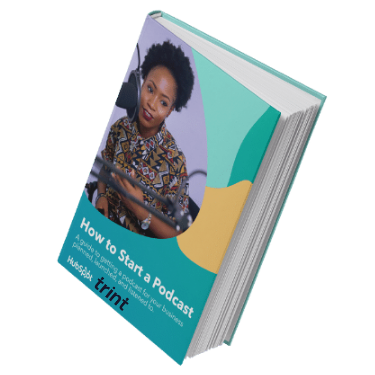
How to Start a Podcast for Your Business
Everything you need to create, record, launch, and promote your podcast, including:
-
Building Your Feed
-
Producing Your Podcast
-
Promoting Your Podcast
-
Measuring Success
3. Name your podcast and secure social media handles.
At this point, you know what your podcast is about and have identified your ideal listener. Now, it’s time to choose a name.
Whether your podcast name is related to your business or something entirely new, perform an extensive search to ensure the name you want is available. You don’t want to pick a title already associated with any other podcasts, brands, or registered trademarks.
At this stage, I also recommend registering the domain name and social media accounts you’ll be using to promote the podcast and engage your audience. While you won’t need them right away, the last thing you want is to create artwork and produce your podcast, only to find out that the handles you want have been taken.
Pro tip: Running a search in the U.S. Patent and Trademark websites can help you ensure there are no existing trademarks on the name you want.
For more insights on choosing the right niche, naming your show, and more, you can check out HubSpot’s video on nine pro tips for starting a podcast.
9 Pro Tips to Start Your Podcast in 2024 (FREE Guide)
4. Decide which format and publishing schedule you’d like to follow.
After naming your show, it’s time to get into the weeds of what your podcast will look like by choosing the format type and your publishing cadence.
Common podcast formats include:
- Scripted.
- Interviews.
- Storytelling.
- Documentary.
- Conversations.
When considering the publishing cadence you’d like to follow, note that the most common podcast publishing schedules are weekly, bi-weekly, and monthly. That said, consistency is more important than frequency when it comes to podcasting. Above all, choose a schedule you can maintain.
Pro tip: Denhoff recommends starting with your podcast’s purpose, suggesting that you “define the value your podcast aims to provide. Are you filling a need for news, education, or entertainment? Your content should align with the role it plays in your audience’s life.”
For instance, if the value you provide is entertainment, then a scripted or storytelling format might work best. Conversely, since one of my goals is to amplify the voices of Black women in the wellness space, most of my show uses an interview format.
5. Select a podcast hosting service.
Now, you want to select a podcast hosting platform. These platforms help you store episodes and make them available in RSS feeds so you can distribute them on platforms like Spotify or Apple Podcasts.
I think Buzzsprout is an excellent place to start, as it offers a free plan and low-cost paid tiers. If you want more advanced features like monetization options, listener analytics, and subscriptions, premium services like Captivate or Libsyn could be a good fit for you.
Pro tip: Get your own website. This way, you can switch hosting services if need be while providing a seamless transition for your listeners.
6. Create podcast cover art.
Your cover art gives podcast listeners a first impression of your show before they press play, so you want it to be good. I like using tools like Canva to create my cover art and templates for different types of episodes.
Before I started to work on my own graphics, I found it helpful to browse directories like Spotify, Apple Podcasts, and Google Podcasts to identify common visual elements among the top-rated shows and add those that suited my brand.

When creating your artwork, make sure that:
- It’s easy to read in smaller sizes.
- It’s consistent with your branding.
- It’s a clear image that doesn’t appear blurry.
- It doesn’t contain any copyrighted images or logos of non-affiliated companies.
Pro tip: It’s also imperative that your podcast artwork is the correct size. Apple suggests using a 3,000x3,000-pixel image to future-proof your artwork.
Incorrect sizing can impact your podcast’s ability to publish and display in directories correctly, so you’ll want to make sure your artwork is the right size. So, when your artwork is complete, upload it to your podcast hosting service to ensure it shows up correctly across platforms.
7. Get your podcasting equipment.
Your podcast recording setup can be as complex or as simple as you’d like. If you’re opting to record at a local studio, this would be the perfect point in the process to research options near you and book a recording session.
If you plan to record at home and are looking for a straightforward setup, you’ll need the following:
- Headphones.
- A laptop or computer.
- Recording software such as Squadcast, Zencastr, Zoom, or Riverside.
- A USB or XLR microphone (if you use an XLR microphone, make sure you get a mixer to connect the mic to your computer).
- Editing software such as Alitu, GarageBand, Audacity, Adobe Audition, or Descript.
Pro tip: You don’t need to break the bank on recording equipment to start a high-quality podcast. Check out this list of recommended podcast tools and find the items that fit your budget and experience level.
8. Create a roadmap and reach out to potential guests.
While you may be itching to get behind the mic at this point (I know I was), I found it helpful to create a high-level outline of your show’s first 10 to 20 episodes before you record.
When I spoke with Joe Fier of The Hustle & Flowchart podcast, he described one way you can break down the first 20 episodes based on their purpose:
- Introduction: 1 episode (5%).
- Value episode: 6 episodes (30%).
- Community episodes: 3 episodes (15%).
- Offer episodes: 2 episodes (10%).
- Guest appearances: 4 episodes (20%).
- Repurposed content spotlight: 4 episodes (20%).
This is just one example and can be adapted based on your genre and the content types you’ve chosen to create.
If you plan to interview guests, I recommend creating your guest list and reaching out at this stage. I found that confirming availability with guests helps me plan out my podcast schedule in advance so I can stay consistent with my publishing schedule.
Pro tip: If you plan on featuring other people in your podcast, look at your existing network for potential guests. It’s tough to get people on board with cold outreach if you don’t have any existing material people can review before they agree to the interview.

How to Start a Podcast for Your Business
Everything you need to create, record, launch, and promote your podcast, including:
-
Building Your Feed
-
Producing Your Podcast
-
Promoting Your Podcast
-
Measuring Success
9. Plan your launch episodes in more detail.
Once you know your overall plan, you can map out more details about the episodes that will accompany your launch. Yes, episodes.
After all, getting podcast listeners isn’t that different from how music artists draw attention to their work — you lure them in with a good song, but it’s not until they’ve listened to the other songs in the album that you have truly caught them.
Fier agrees and states, “Launching with two or three episodes is best because you want to keep your audience in that momentum.”
In my experience, starting with a few episodes also gives you a chance to earn more downloads, ratings, and reviews in a shorter period of time, which can be helpful for discoverability and ranking on the charts.
Fier goes on to recommend using the first episode as an introduction that “highlights your expertise and then shows people where you’re going to take them in your podcast.” From there, you can use the follow-up episodes to show them what that looks like.
Pro tip: If you plan to feature guests in your show, Fier suggests bringing your first guest early on to introduce your audience to the type of interviews they can expect. “It’s also a great marketing strategy to get a guest to introduce you and your show to their audience,” he says.
10. Record and edit your first three episodes.
With the outline of each episode in your launch plan, it’s time to record and edit. Before recording, I like to create a script for each podcast episode outlining the points I want to make (if it's a solo show) or the questions I’d like to ask the guest I’m interviewing.
Creating a solid script or outline is especially helpful when you’re a new podcaster getting used to the medium.
Once your scripts are ready, record your launch episodes in your recording software of choice. You can then edit them yourself or hire an editor to do so. When editing, be mindful of background noise and filler words that could distract the listener.
Pro tip: Read your scripts out loud to hear how they sound. This will help you imagine your content as a podcast before you start recording.
11. Write the show notes for your launch episodes.
Now that your first few episodes are recorded, it’s time to write the show notes.
Show notes are essentially short blog posts that accompany each podcast episode. They are a great place to put a general description of the episode along with community links, such as an email sign-up.
When I write show notes, I like to include:
- A general summary of the episode.
- Time-stamped chapters of different topics we cover.
- Information about my guest (if it’s an interview).
- Links to sponsors and any mentioned resources.
While it can be tempting to gloss over show notes, it’s worth putting in some effort. I’ve found that besides helping with SEO, which can bring new listeners to your show, show notes can also keep your audience engaged and ready to follow your content on other platforms.
Pro tip: Include links to relevant resources, such as books or studies you mention during the show. This creates more value for listeners and can increase engagement.
12. Create a podcast trailer.
As one final step before uploading your first show, record a trailer. A trailer is a short audio clip that introduces your podcast to new listeners and gets them excited to tune in. In your podcast trailer, you’ll want to include:
- An introduction to your podcast and what it’s about.
- When listeners can expect new episodes.
- A teaser of what’s to come or highlights so the audience knows what to expect.
- A call-to-action inviting the listener to come back.
Pro tip: Keep your trailer engaging and informative but concise. One to two minutes in length is all you need.
13. Upload and schedule your trailer and launch episodes.
Now that you have your first three episodes, show notes, and a trailer, you’re ready to publish. Upload your audio files and show notes to your podcast host, and schedule your episodes to publish on your desired launch date.
Pro tip: Your launch date should fall on the day of the week you plan to publish moving forward so your audience knows right from the start when to tune in.
14. Submit your podcast to online podcast directories.
Once your first episodes are uploaded to your podcast service, it’s time to submit to podcast directories so listeners can tune in to your show. Remember that directories can take a few days or a couple of weeks to approve your podcast. You’ll want to factor that time into your launch plan.
I recommend starting with the platforms that have the widest reach. The top three podcast directories based on number of listeners are:
- Spotify, with 25% of total listeners.
- Apple Podcasts, with 20% of total listeners.
- Google Podcasts, with 16% of total listeners.
Streaming your podcast to other platforms such as Stitcher, Castbox, Pandora, and Amazon Music can be managed within your podcast host settings.
Pro tip: Revisit step two to see which streaming services your ideal listener uses to discover and follow their podcasts.
15. Market your podcast and celebrate your launch.
Congratulations — you just launched your first podcast! Now, it’s time to get the word out by marketing your show to your ideal listeners and celebrating your hard work.
I’ve found that short-form videos are excellent ways to promote my podcasts, so I use Instagram reels to highlight top clips from my interviews.
Pro tip: Fier suggests leveraging YouTube as a podcast marketing channel, saying, “Video is going to be a piece of podcasting in this day and age. YouTube will be where a lot of momentum is happening for podcasts because of their algorithm.”
For even more information on organizing, producing, and marketing your podcast, download our Ultimate Guide to Starting a Podcast for free. You’ll even get email outreach templates and tips on the best ways to measure success.

Things To Know Before Starting a Podcast
After publishing more than 270 episodes of my show, I can say that the journey has been exciting, surprising, and rewarding. When I recall my early days, there were plenty of things I had yet to learn.
Here are a few things I recommend knowing before you start a podcast.

Know the value of guests.
Getting used to the podcast format can take some time. To give yourself a head start, Fier says, “Guesting on other shows can be the best first step because you get to practice the muscle.”
Plus, guesting is also an excellent way to reach a wider audience and promote your own show in the long term.
Listeners don’t mind ads as much as you think.
Compared to other marketing channels, podcasting is one of the more advertising-friendly options. One survey showed that 46% of podcast listeners don’t find ads intrusive at all. In contrast, 77% of people find ads somewhat or very intrusive on YouTube, and 64% find ads somewhat or very intrusive on TV.
As such, don’t feel shy about working with sponsors who are a good fit for your brand. In a podcast setting, ads are less likely to be a turnoff for listeners. If you can tie ads into the theme of your show or episode, they can be especially valuable for your audience.
Podcasts take preparation.
Podcasts are an excellent way to build community with your target audience, but if you want to grow your show’s audience, you must prepare. From identifying your ideal listener and drafting a launch plan to crafting outlines for each show, the importance of research, planning, and preparation never goes away.
That said, you don’t need to achieve perfection to be prepared. Trust me, though, I know the temptation of getting every detail just right. Once you’ve done the work, the best thing you can do is to get started. Over time, you can adjust your strategy based on your metrics and listener feedback.
Everything You Need to Start Your Podcast Today
I honestly love the podcast medium and believe more and more people should give it a try. And remember — if you’ve got a podcast idea that’s chomping at the bit, this podcast launch checklist can serve as a roadmap to turning it into a reality.
Editor's note: This post was originally published in September 2022 and has been updated for comprehensiveness.
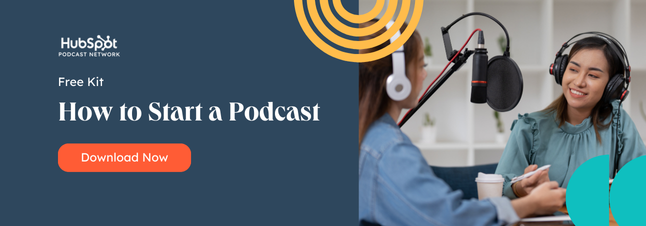


![How to Start a Podcast on Spotify for Free [+ Expert Insight]](https://blog.hubspot.com/hubfs/spotify%20podcasts.png)
